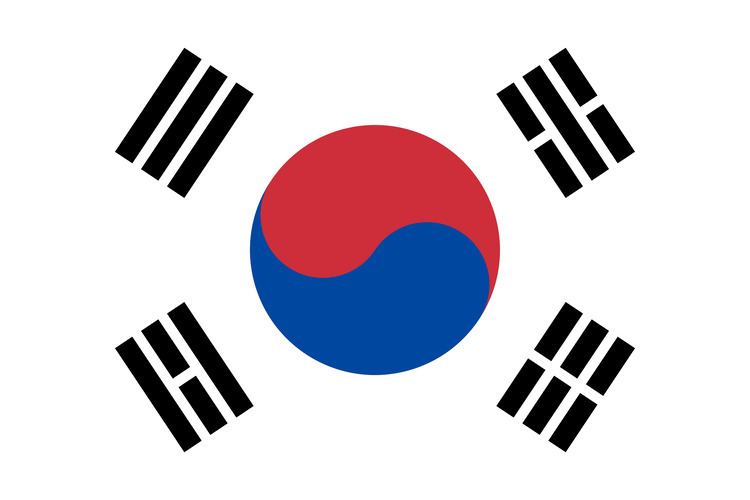Use National flag, Ensign Proportion 3:2 | Adopted on 1948 Country South Korea | |
 | ||
Name Taegukgi / Taegeukgi
(Korean: 태극기)
(Hanja: 太極旗) | ||
The flag of South Korea, also known as the Taegukgi (also spelled as Taegeukgi, literally "Taeguk flag"), has three parts: a white rectangular background, a red and blue Taeguk in the center that symbolizes a balance, and four black trigrams, which are selected from the original eight, on each corner of the flag.
Contents
Design
The flag's background is white, which is a traditional Korean color, common to the daily attire of 19th century Koreans and the color is also use for a traditional Korean wear (hanbok). It represents peace and purity. The circle in the middle is derived from the philosophy of yin-yang and represents the balance of the universe. The blue section represents the negative cosmic forces, and the red section represents the opposing positive cosmic forces. The trigrams together represent the principle of movement and harmony. Each trigram (hangeul: 괘 [gwae]; hanja: 卦) represents one of the four classical elements.
These four trigrams are described in the table below:
History
The lack of the national flag only became an issue in 1876, in the Joseon Dynasty. Before 1876, a national flag did not exist and it was not considered important. The issue began during the negotiations for the Japan–Korea Treaty of 1876. Although the delegate of the Empire of Japan had the Japanese national flag, the Joseon Dynasty could not hang a corresponding flag. Thus, there were some proposals to create a flag, but the issue was considered unimportant by the government. At 1880, the proliferation of foreign negotiations led to a need for the national flag. The most major proposal was described in the ‘Korea Strategy’ papers written by the Chinese delegate Huang Zunxian. The proposal was to incorporate the Flag of the Qing Dynasty for the Joseon Dynasty. In response to the proposal, the government sent the delegate of Lee Young-Sook to explore the possibility of the issue through the politician Li Hongzhang. Li Hongzhang agreed with some parts of the proposal, but proposed that some other factors should be differed. The Qing Dynasty agreed with Li Hongzhang, but it is unknown how far the Joseon government explored this proposal.
The issue was then shelved but reemerged with the ratification of the United States–Korea Treaty of 1882. The controversy arose after the delegate Lee Eung-Jun presented a flag similar to the flag of Japan to the Chinese official Ma Jianzhong. In response to the discussion, Ma Jianzhong argued against the proposed idea of using the flag of the Qing Dynasty and proposed a flag with a white background, with a half-red and half-black circle in the center, with eight black bars around the flag. On August 22, 1882, Park Yeong-hyo created a scale model of the Taegukgi to the Joseon government. Park Yeong-hyo became the first person to use the Taegukgi in the Empire of Japan in 1882. On January 27, 1883, the Joseon government officially promulgated Taegukgi to be used as the official national flag.
Before the division of Korea, a flag similar to the current South Korean flag was used for the entire country. However, after the division, two flags started to be used, the flag of South Korea and the flag of North Korea. The current South Korean flag was declared official by the government of South Korea on October 15, 1949, although it had been used as the de facto national flag before then.
In October 1997, the exact colors of the flag were specified via presidential decree.
Dimensions
The width and height are in the ratio of 3 to 2. There are five sections on the flag, the taegeuk and the four groups of bars. The diameter of the circle is half of the height. The top of the taegeuk should be red and the bottom of the taegeuk should be blue. The groups of bars are put in the four corners of the flag.
Colors
The colors of Taegukgi are specified on the "Ordinance Act of the Law concerning the National Flag of the Republic of Korea." (Korean: 대한민국 국기법 시행령) There were no specification for shade of colors until 1997, when South Korean government decided to provide standard specification for the flag. In October 1997, a Presidential ordinance on the standard specification of the South Korean flag was promulgated, and that specification was acceded by the National Flag Law in 2007.
The colors are defined in legislation by the Munsell and CIE color systems:
